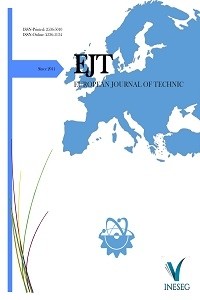Assessment of Risky Buildings according to the Regulation for Determination of Risky Buildings (RDRB 2019): The Case of Şanlıurfa
Assessment of Risky Buildings according to the Regulation for Determination of Risky Buildings (RDRB 2019): The Case of Şanlıurfa
Risky buildings, Earthquake, RDRB,
___
- [1] E. Tüzün. Home / living space: post-disaster needs. Master Thesis. Istanbul Technical University, Institute of Science and Technology. Istanbul. 2002. [2] A. Ünal. Reinforcement of reinforced concrete frames not designed according to TDY 2007 with a toothed shear wall. Selcuk University Graduate School of Natural and Applied Sciences. Konya. 2012. [3] TMMOB Chamber of Geological Engineers (jmo.org.tr)
- [4] Ulutas H. Comparison of DBYBHY (2007) and TBDY (2018) Earthquake Regulations in terms of Section Damage Limits. European Journal of Science and Technology. vol 17. pp. 351-359. 2019.
- [5] M. Özkaratay. Evaluation of 6-storey Reinforced Concrete Building with Different Methods in Düzce Earthquake. Master Thesis. Istanbul Technical University, Institute of Science and Technology. Istanbul. 2014.
- [6] B. Bayraktargil. Principles of Detection of Risky Buildings and Comparison of Turkish Earthquake Code. Master Thesis. Istanbul Technical University, Institute of Earthquake Engineering and Disaster Management. Istanbul. 2015. [7] K. Yeşilkaya. Analysis of reinforced concrete structures determined by rapid observation techniques with the "Detection Principles of Risky Structures 2013" regulation. Master Thesis. Ondokuz Mayıs University, Institute of Science and Technology. Samsun. 2015.
- [8] M. Olbak. Reusability and Benefits of Risky Buildings with Non-Linear Analysis Methods of Urban Transformation in the Light of Experimental Data. Master Thesis. Istanbul Aydın University Institute of Science and Technology. Istanbul. 2016.
- [9] S. Altın Karayahshi. Comparison of Existing Building Evaluation and Risky Building Evaluation in Public Buildings. Master Thesis. Celal Bayar University Institute of Science and Technology. Manisa. 2016.
- [10] Z. Korkmaz. Comparison of the "Japanese Seismic Method" and the "Detection Principles of Risky Structures 2013" Regulation in Determining the Earthquake Performance of Buildings. Master Thesis. Maltepe University Institute of Science and Technology, Istanbul. 2017. [11] E. Bahşi. Comparison of Principles Regarding Detection of Risky Buildings and First and Second Stage Evaluation Methods. Master Thesis. Gazi University Institute of Science and Technology, Ankara. 2017.
- [12] E. Ekinci. Urban Transformation Studies and Cost Analysis for Risky Building Stock in Turkey: A Case Study. Master Thesis. Gazi University Institute of Science and Technology. Ankara. 2018.
- [13] S. Can. Evaluation of Risky Buildings by Earthquake Safety Screening Method. Master Thesis. Istanbul Technical University, Institute of Science and Technology. Istanbul. 2019.
- [14] O. Kınaş. Risky Buildings and Urban Transformation Studies, Tunceli Example. Master Thesis. Suleyman Demirel University, Institute of Science and Technology. Sparta. 2019.
- [15] Hacımustafaoglu. S.F. Altan. M.F. Naim. S. Determination of Risk Situations of Risky Buildings by Observational Analysis. Aurum Journal of Engineering Systems and Architecture. vol. 5.1 pp. 109-118.
- [16] Gürbüz. A. and Tekin. M. Determination of Regional Earthquake Risk Distribution of Existing Buildings by Performance Ranking Method. Celal Bayar University Journal of Science. vol. 11.1 pp. 37-48. 2015.
- [17] Işık. E. Calculation of the Performance Score of a Damaged Reinforced Concrete Building. International Anatolia Academic Online Journal. vol. 3, 2, pp. 47-52. 2015.
- [18] Işık. E. and Dusty. Z. Calculation of Building Performance Score Using Different Variables. Bitlis Eren University Journal of Science. vol. 4.2 pp. 161-172. 2015.
- ISSN: 2536-5010
- Yayın Aralığı: Yılda 2 Sayı
- Başlangıç: 2011
- Yayıncı: Hibetullah KILIÇ
İsmail Ümit ÇIKMAN, Mehmet Emin ÖNCÜ, Şermin KOÇYİĞİT
Determination of Antioxidant Activity of Dietary Selenium, Oleuropein, Glutathione Mixture
Increasing The Tensile Strength of Adhesive T-Type Joints with Bio-Inspired 3D Printed Inserts
Mirari Ğunav GEÇİT, Tolga TOPKAYA
Efficiency Analysis in Solar Air Heaters with Attached Internal Fins
Fevzi GÜLÇİMEN, Hakan KARAKAYA, Aydın DURMUŞ
Investigation of Static and Dynamic Analysis of Asynchronous Motors in the Cement Industry
Hayrullah Çağtay ALKAYA, Sertaç GÖRGÜLÜ
Teaching Algorithms Design Approaches via Interactive Jupyter Notebooks
Günay ÖNAL, Abdulkadir LEVENT, Zühre ŞENTÜRK
Q-Learning Based Obstacle Avoidance Data Harvesting Model Using UAV and UGV
